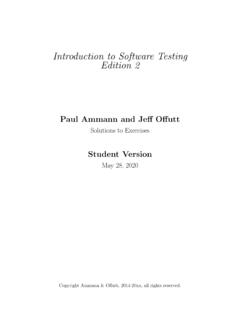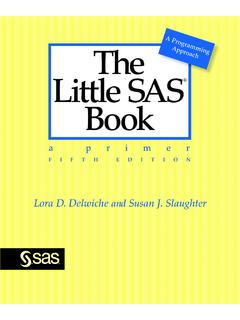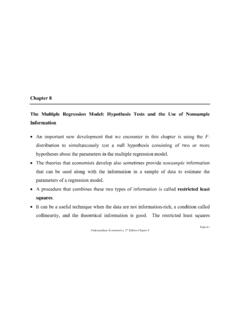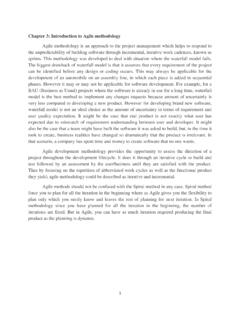Transcription of Chapter 1 ADAMS/Solver and MSS - University of Rochester
1 An Overview of How to Use ADAMS/Solver 1 Chapter 1 ADAMS/Solver and MSSI ntroductionThis Overview introduces the computer program Automatic Dynamic Analysis of Mechanical Systems (ADAMS). Engineers use ADAMS/Solver in the field of Mechanical System Simulation (MSS) to simulate both large and small scale motion of mechanical systems. These motions are induced by the action of applied forces or excitations that act upon the system. The purpose of this Overview is to help you use ADAMS/Solver to design and analyze mechanical systems from the most elementary pendulum, or four-bar mechanism, to the very complex suspension systems and other sophisticated mechanical devices. If you are a more experienced ADAMS/Solver user, you will learn about the most recent innovations in the Overview includes the following chapters and appendix:1. ADAMS/Solver and MSS. Describes the role of ADAMS/Solver simulation code in the field of Mechanical Systems Concepts.
2 Introduces necessary ideas to construct models for an ADAMS/Solver analysis. 3. Modeling Process. Describes a sequence of steps to create an ADAMS/Solver model, run a simulation, and review the Statements. Defines the syntax and format of statements used to define input for an ADAMS/Solver ADAMS/Solver . Describes customizing procedures to define nonstandard modeling elements or to generate nonstandard ADAMS/Solver . Discusses procedures to initiate an ADAMS/Solver simulation and to control the Files. Summarizes the purpose and contents of various output A. The Ten Easy Steps to Happy Simulations. Methods for avoiding the commonly encountered pitfalls associated with ADAMS/Solver 1. ADAMS/Solver and MSS2An Overview of How to Use ADAMS/Solver Definition of MSS Mechanical System Simulation (MSS) is the study of the motion of mechanical systems caused by external forces and excitations that act on the system. MSS simulates large displacement motion, , the extent of the relative motion of the components can be on the order of the overall dimensions of the system.
3 The mechanical system consists of rigid and flexible parts interconnected by various kinds of joints and other constraining forces. The net reaction and applied forces drive the relative motion of the parts. MSS software is of growing, fundamental importance to modern Mechanical Computer-Aided Engineering (MCAE). It allows you to evaluate the design characteristics and performance of a product prior to fabrication of the prototype. With MSS software, you can reduce product development costs, evaluate more design alternatives, and reduce the time it takes to bring a new product to 1. ADAMS/Solver and MSSAn Overview of How to Use ADAMS/Solver The Relationship of MSS to Other TechnologiesThe MSS software complements other programs used for Mechanical Computer-Aided Engineering. MSS can incorporate data from other software products into a complete simulation of system behavior. MSS also produces output that assists in further analysis with other computational tools.
4 As Figure 1 illustrates, MSS software exchanges data with other applications. A discussion of these applications follows Figure 1. Figure 1. MSS Software Design (CAD) creates mechanical models for MSS and displays MSS simulation Element Analysis (FEA) computes mass, stiffness, and damping information to describe flexible bodies in MSS, and uses forces computed by MSS to determine system loads and boundary conditions. with software that simulates multidomain actuators, MSS models systems that interact with the forces and power flow from electrical, hydraulic, pneumatic, and mechanical uses the output from the modal analysis of an experimental device in a linearized component of an MSS model for a mechanical design packages can apply the techniques of classical and modern control theory to the analysis of system motion simulated with MSS software evaluates system behavior predicted by MSS and adjusts system parameters to improve performance.
5 In summary, other software programs can use MSS output, provide data for an MSS analysis, or both. MSS plays an important role in integrating MCAE applications. MechanicalSystemSimulation StructuralAnalysis(FEA)GeometricModeling (CAD)ComponentActuationModelingOptimizat ionControlSystemDesignModalAnalysisChapt er 1. ADAMS/Solver and MSS4An Overview of How to Use ADAMS/Solver ADAMS/Solver as a Computational Tool for MSSThe capabilities of computer software have made advanced Mechanical System Simulation widely available. In particular, the ADAMS/Solver simulation code is an important computational tool in the field of Mechanical Computer-Aided Engineering (MCAE).During a simulation, ADAMS/Solver describes the locations and orientations of all mechanical system parts in terms of six coordinates, three translational, and three angular. ADAMS/Solver stores time-dependent translational and angular displacements, velocities, and accelerations in the state vector.
6 The state vector also contains current values of the reaction and applied forces on each of the parts at the constrained and inertial locations. Thus, the state vector provides a complete description of the mechanical system for a mechanical system can use the information that an ADAMS/Solver simulation generates to verify the following: System performance characteristics System response to a set of operating conditionsOn the basis of the simulation results, you can adjust the design parameters to improve the performance of the system. A variety of industries use ADAMS/Solver as described below: The automotive industry uses ADAMS/Solver for the design and evaluation of -new and better suspension systems-ride and handling characteristics of passenger vehicles-anti-lock braking systems The aerospace and aircraft industries use ADAMS/Solver for the testing of virtual prototypes of -automatic control systems for maintaining satellite attitude-minimization techniques for the effects of the interaction between system controls and the mechanical structure-various other mechanisms such as landing gears and latching devices for aircraft doors The general machinery industry uses ADAMS/Solver to compute and analyze the design characteristics for -the power requirements for industrial appliances, such as an orange juice machine-the intricate mechanisms in cameras, video recorders, and computer disk drives-robotic systems-the high-speed switching mechanisms for electrical relaysChapter 1.
7 ADAMS/Solver and MSSAn Overview of How to Use ADAMS/Solver 5 Figures 2 and 3 are typical of specific applications for the ADAMS/Solver simulation code. Figure 2 illustrates a backhoe, while Figure 3 illustrates a satellite with solar panels. Figure 2. Backhoe Work CycleFigure 3. Satellite in Orbit About the EarthBackhoe Work CycleChapter 1. ADAMS/Solver and MSS6An Overview of How to Use ADAMS/Solver In Figure 2, ADAMS/Solver simulates part of the work cycle of a backhoe as it digs into the ground with the bucket, scoops up the dirt, and lifts the dirt. In response to articulation instructions from the hydraulic systems, ADAMS/Solver computes all of the reaction forces on the components of the equipment. The scale for the motion of the backhoe is comparable to its overall dimensions. The excitations (movement of the hydraulic cylinders) and applied forces (interaction between the bucket and the ground) for the backhoe are highly nonlinear and dependent on the instantaneous state of the mechanical system.
8 These are all typical characteristics of problems for mechanical system Figure 3, the gravitational magnetodynamic and aerodynamic forces and moments affect the satellite in orbit about the earth. Because of weight restrictions on a satellite, the solar panels are extremely flexible. ADAMS/Solver computes the effects of the panel flexibility and deformation on the satellite s overall motion. This information is necessary to design and verify a control system to maintain the attitude of the principal axes of the spacecraft as it moves about the Input Specifications for the ADAMS/Solver CodeThe physical laws of mechanical engineering are the basis for the field of MSS. The MSS simulation tools implement Newton s laws of motion, or an equivalent formulation of the physical principles. ADAMS/Solver uses the system of Euler-Lagrange equations of motion. This system, composed of algebraic and second order differential equations, requires sophisticated numerical methods for their defines the following to specify the mechanical model for a simulation: The inertial characteristics of the parts The relationships between parts The driving motions and forces for the systemThe model can also include additional differential (first order) and algebraic equations coupled to, or independent of, the mechanical 1.
9 ADAMS/Solver and MSSAn Overview of How to Use ADAMS/Solver 7 The input data for an ADAMS/Solver simulation includes the following entities: The mass and inertia of the rigid bodies or parts The definition of the geometric aspects of the system including the centers of mass for the parts, the locations on the parts for the joints that hold the system together, and the points at which the specified motion functions and forces apply The connectivity for the system (the mechanisms for connecting the parts) defined in terms of mechanical joints, higher-pair contacts, other constraints and elastic elements A description of the external forces and excitations acting on the system The graphical attributes that enable animation and visualization of the system behaviorA library of standard joints and higher-pair contacts simplifies the task of defining the connections between parts of the system. Each ADAMS/Solver simulation begins with an analysis of the input data verifying that the description of the mechanical system is Complete Correct ConsistentThe verification process is thorough.
10 A comprehensive set of messages will identify any errors that can occur in the input data. ADAMS/Solver assembles the differential and algebraic equations (DAEs) for the actual simulation of the problem only after the input data passes the above listed standards. Chapter 1. ADAMS/Solver and MSS8An Overview of How to Use ADAMS/Solver The Analysis ModesADAMS/Solver can perform six different types of analyses depending on the characteristics of the problem and the interests that you have. Each of these analysis modes is useful in the appropriate context. As described in the following paragraphs, the various analyses provide different information about the performs an initial conditions analysis (the assembly process) prior to the static, quasi-static, and dynamic analyses. After processing the input data and before a simulation begins, ADAMS/Solver requires a consistent set of values for the state of the system. That is, the displacements and velocities have to satisfy the constraint equations that define the system.






